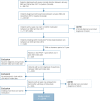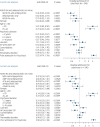Treatment with psychostimulants and atomoxetine in people with psychotic disorders: reassessing the risk of clinical deterioration in a real-world setting
- PMID: 38044665
- PMCID: PMC10884826
- DOI: 10.1192/bjp.2023.149
Treatment with psychostimulants and atomoxetine in people with psychotic disorders: reassessing the risk of clinical deterioration in a real-world setting
Abstract
Background: Although attention-deficit hyperactivity disorder (ADHD) is often comorbid with schizophrenia spectrum and other psychotic disorders (SZSPD), concerns about an increased risk of psychotic events have limited its treatment with either psychostimulants or atomoxetine.
Aims: To examine whether the risk of hospital admission for psychosis in people with SZSPD was increased during the year following the introduction of such medications compared with the year before.
Method: This was a retrospective cohort study using Quebec (Canada) administrative health registries, including all Quebec residents with a public prescription drug insurance plan and a diagnosis of psychotic disorder, defined by relevant ICD-9 or ICD-10 codes, who initiated either methylphenidate, amphetamines or atomoxetine, between January 2010 and December 2016, in combination with antipsychotic medication. The primary outcome was time to hospital admission for psychosis within 1 year of initiation. State sequence analysis was also used to visualise admission trajectories for psychosis in the year following initiation of these medications, compared with the previous year.
Results: Out of 2219 individuals, 1589 (71.6%) initiated methylphenidate, 339 (15.3%) amphetamines and 291 (13.1%) atomoxetine during the study period. After adjustment, the risk of hospital admission for psychosis was decreased during the 12 months following the introduction of these medications when used in combination with antipsychotics (adjusted HR = 0.36, 95% CI 0.24-0.54; P < 0.0001).
Conclusions: These findings suggest that, in a real-world setting, when used concurrently with antipsychotic medication, methylphenidate, amphetamines and atomoxetine may be safer than generally believed in individuals with psychotic disorders.
Keywords: Attention-deficit hyperactivity disorders; CNS stimulants; comorbidity; drug or substance interactions and side-effects; psychotic disorders/schizophrenia.
Conflict of interest statement
O.C. is currently receiving a fellowship award from the Canadian Institutes of Health Research (#202210MFE-491926-64860). L.B. is currently receiving a doctoral training scholarship from the Fonds de recherche du Québec – Santé (#331332). E.S. has received unrestricted grants from Lundbeck Canada Inc. and Otsuka Canada Pharmaceutical Inc. and has served on advisory boards and been a lecturer for Lundbeck Canada Inc., Otsuka Canada Pharmaceutical Inc. and Janssen. M.-F.D. has received consulting fees from AbbVie and has served on advisory boards and been a lecturer for AbbVie and Otsuka-Lundbeck Alliance Canada. M.-A.R. has received unrestricted grants from Mylan Canada and Otsuka-Lundbeck Alliance Canada, has served on advisory boards for AbbVie, Janssen and Otsuka-Lundbeck Alliance and has been a lecturer for AbbVie and Janssen Canada.
Figures



References
-
- Sayal K, Prasad V, Daley D, Ford T, Coghill D. ADHD in children and young people: prevalence, care pathways, and service provision. Lancet Psychiatry 2018; 5: 175–86. - PubMed
-
- Cherkasova MV, Roy A, Molina BSG, Scott G, Weiss G, Barkley RA, et al. Review: adult outcome as seen through controlled prospective follow-up studies of children with attention-deficit/hyperactivity disorder followed into adulthood. J Am Acad Child Adolesc Psychiatry 2022; 61: 378–91. - PubMed
-
- Nourredine M, Gering A, Fourneret P, Rolland B, Falissard B, Cucherat M, et al. Association of attention-deficit/hyperactivity disorder in childhood and adolescence with the risk of subsequent psychotic disorder: a systematic review and meta-analysis. JAMA Psychiatry 2021; 78: 519–29. - PMC - PubMed
-
- Jutla A, Califano A, Dishy G, Hesson H, Kennedy L, Lundgren B, et al. Neurodevelopmental predictors of conversion to schizophrenia and other psychotic disorders in adolescence and young adulthood in clinical high risk individuals. Schizophr Res 2020; 224: 170–2. - PubMed
Publication types
MeSH terms
Substances
Grants and funding
LinkOut - more resources
Full Text Sources
Medical

